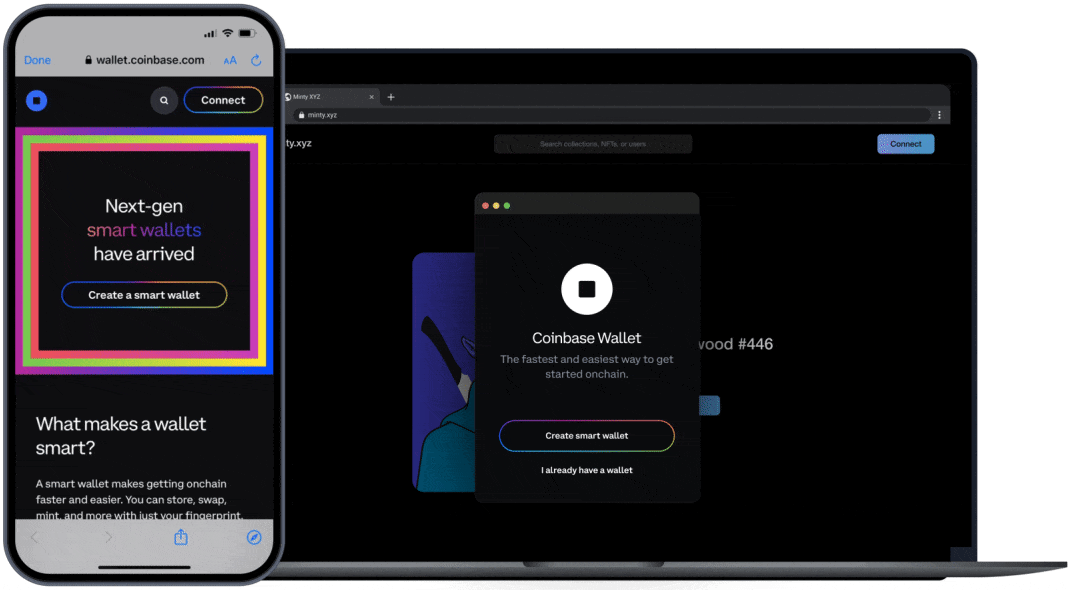What is a crypto smart wallet?
In issue 21 of the newsletter, we take a look at crypto smart wallets and why this week's rollout of the Coinbase Smart Wallet could be a big deal.

Crypto and onchain apps have enormous potential. But there is still a lot of friction required to get set up and to start doing more onchain.
This week, to smooth some of that friction, Coinbase rolled out its version of a smart wallet. The launch feels like the beginning of a big user experience shift within the crypto space.
Under current conditions, setting up a wallet requires several steps, such as:
- Deciding which web3 wallet to use
- Funding the wallet
- Making sure the wallet supports the onchain apps you want to use (if not, you need to set up another wallet)
- Selecting the right network for the activity or action performed
- Figuring out or managing gas or transaction fees
That’s a lot of steps.
The key innovation of a crypto smart wallet is it takes all of the steps outlined above and abstracts them into an easy to use browser integration that is secure and still inline key management best practices.
It’s why this week’s smart wallet rollout could be the beginning of a shift towards a more user-centric and seamless crypto experience.
After all, if it’s easy and intuitive to get started and people don’t feel overwhelmed by decisions or technical glitches, then it opens up possibilities for the next wave of people to start moving onchain.

Smart wallet and key management
The best part about a smart wallet, from a user perspective, is that you still control your keys. Unlike other solutions designed to bring crypto the the mainstream, like the rollout of Bitcoin ETFs and more recently Ethereum ETFs, for example, a smart wallet enables easy access and complete non-custodial control.
Until recently, like a lot of other things in crypto, the concept of a smart wallet felt very theoretical.
For years, the crypto advocates have been drilling the mantra, “Not your keys, not your crypto.”
Put a another way, the friction encountered during crypto onboarding felt like it was part of the extra layer of security, or a tradeoff to be able to transact in assets that you have full control over.
While that tradeoff seemed reasonable for many, it was also a big barrier to entry for most. That’s why the reality of a smart wallet or a “one-click” setup for crypto onboarding that still preserves self-custody features is such a level-up.
Smart wallet key management happens through passkey technology, which you might have noticed is becoming more and more common.
No special software or hardware is required.
Besides solving the key management issue, using a passkey also means you can protect your wallet biometrics, like fingerprints or face scans.
Gasless user experience and networks supported by Coinbase smart wallet
Another of the big problems solved by smart wallets is that it makes it possible to manage onchain gas, or user transaction fees, differently.
The current style of management means the app users are responsible for figuring out and paying gas if required for the transaction.
While gas fees, at least on Ethereum-based apps continue to decline thanks to recent Ethereum upgrades and modular design architectures, gas management continues to be an issue — and a potential source of friction for onchain app use.
One of the interesting functionalities of new smart wallets is that apps can create a paymaster setup or a means of handling or managing gas fees on their apps. This makes it possible that app users don't have to deal with the fees themselves.
One condition or potential early limitation of the Coinbase smart wallet is that it currently supports eight networks:
It sounds like support for additional networks is on the way, which is what will be needed to truly make onchain apps and environments seamlessly integrated.
Post-script
I don’t like writing posts that make me sound like such a huge fanboy. This post is very one-sided and reads like some marketing material, which is not great.
Part of the reason is that I do think the introduction and adoption of smart wallets could be huge for crypto. And as someone who has written about this space for a while now, it does feel like the smart wallet idea does have killer app kind of vibes.
But, and this is a big but, I haven’t done a good job of exploring the tradeoffs or potential risks for using a smart wallet — or taking a look at potential blindspots.
So, for now, let’s just consider this post more as a means to mark the milestone of the launch of smart wallets more than anything else. We’ll likely need a follow-up highlighting smart wallets in the wild — and/or find competitors outside of the Coinbase ecosystem to get a fuller picture of the full potential of this new technology.